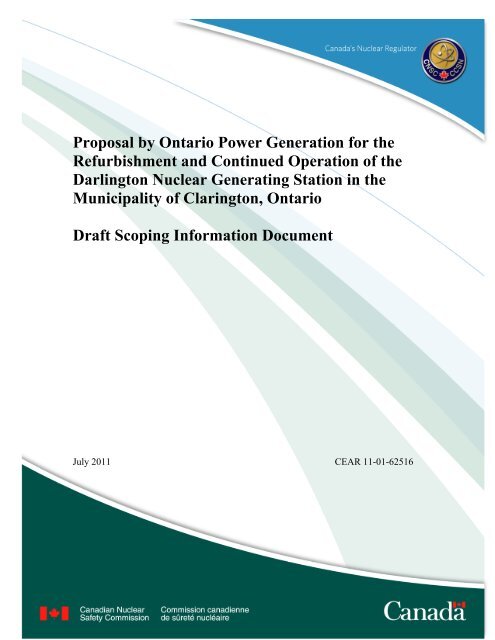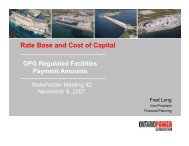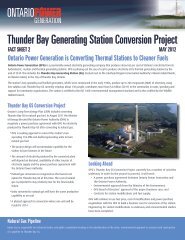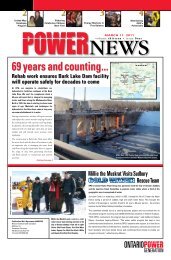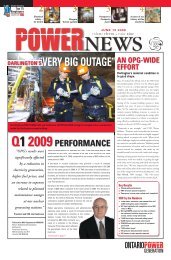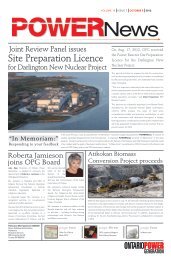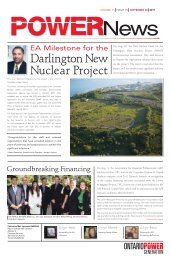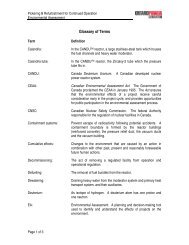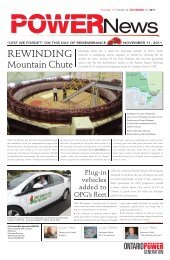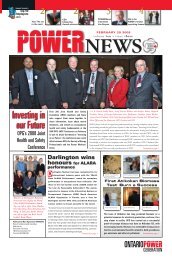Draft Scoping Information Document - Ontario Power Generation
Draft Scoping Information Document - Ontario Power Generation
Draft Scoping Information Document - Ontario Power Generation
You also want an ePaper? Increase the reach of your titles
YUMPU automatically turns print PDFs into web optimized ePapers that Google loves.
Proposal by <strong>Ontario</strong> <strong>Power</strong> <strong>Generation</strong> for the<br />
Refurbishment and Continued Operation of the<br />
Darlington Nuclear Generating Station in the<br />
Municipality of Clarington, <strong>Ontario</strong><br />
<strong>Draft</strong> <strong>Scoping</strong> <strong>Information</strong> <strong>Document</strong><br />
July 2011 CEAR 11-01-62516
July 2011<br />
<strong>Draft</strong> <strong>Scoping</strong> <strong>Information</strong> <strong>Document</strong> - Proposal by OPG - Refurbishment and<br />
Continued Operation - Darlington Nuclear Generating Station, Clarington, <strong>Ontario</strong><br />
OVERVIEW<br />
INTRODUCTION OF PROJECT<br />
The Canadian Nuclear Safety Commission (CNSC) has received a Project<br />
Description [Reference 1 and 2] from <strong>Ontario</strong> <strong>Power</strong> <strong>Generation</strong> (OPG) for the<br />
proposed refurbishment and continued operation of the Darlington Nuclear<br />
Generating Station (DNGS) in the Municipality of Clarington, <strong>Ontario</strong>.<br />
Based on its review of the Project Description, the CNSC has determined that an EA<br />
must be conducted pursuant to the Canadian Environmental Assessment Act (CEAA).<br />
OPG’s project is called the “Darlington Nuclear Generating Station (DNGS)<br />
Refurbishment and Continued Operation Project” and it is registered in the Canadian<br />
Environmental Assessment Registry under project number 11-01-62516.<br />
PURPOSE OF SCOPING INFORMATION DOCUMENT<br />
The purpose of this <strong>Scoping</strong> <strong>Information</strong> <strong>Document</strong> is to:<br />
1. Establish the scope of the EA being carried out for OPG’s DNGS Refurbishment<br />
and Continued Operation Project.<br />
1. Provide OPG with project-specific guidance for the conduct of the environmental<br />
technical studies.<br />
CONTACTS FOR THE ASSESSMENT<br />
Anyone wishing to obtain additional information or provide comments on any aspect<br />
of the EA being conducted on the project may do so through the following CNSC<br />
staff contacts:<br />
Andrew McAllister<br />
Environmental Assessment Specialist<br />
Environmental Assessment Division<br />
Canadian Nuclear Safety Commission<br />
280 Slater Street, P.O. Box 1046<br />
Ottawa, <strong>Ontario</strong> K1P 5S9<br />
Phone: 1-800-668-5284<br />
Fax: (613) 995-5086<br />
Email: EA@cnsc-ccsn.gc.ca<br />
Daniel Desjardins<br />
Senior Regulatory Program Officer<br />
Darlington Regulatory Program Division<br />
Canadian Nuclear Safety Commission<br />
280 Slater Street, P.O. Box 1046<br />
Ottawa, <strong>Ontario</strong> K1P 5S9<br />
Phone: 1-800-668-5284<br />
Fax: (613) 995-5086<br />
e-DOC 3734740 - i -<br />
CEAR 11-01-62516
July 2011<br />
<strong>Draft</strong> <strong>Scoping</strong> <strong>Information</strong> <strong>Document</strong> - Proposal by OPG - Refurbishment and<br />
Continued Operation - Darlington Nuclear Generating Station, Clarington, <strong>Ontario</strong><br />
Table of Contents<br />
OVERVIEW ........................................................................................................................ i<br />
1. BACKGROUND .................................................................................................... 1<br />
1.1 Project Description.................................................................................................. 1<br />
1.2 EA Determination ................................................................................................... 1<br />
1.3 Project Coordination ............................................................................................... 2<br />
1.4 Delegation of Technical Studies ................................................................................... 2<br />
1.5 EA Project Schedule ............................................................................................... 3<br />
2. SCOPE OF THE ENVIRONMENTAL ASSESSMENT....................................... 4<br />
2.1 Scope of the Project ................................................................................................ 4<br />
2.2 Factors to be Considered in the EA ........................................................................ 6<br />
2.3 Scope of the Factors................................................................................................ 6<br />
2.3.1 Spatial Boundaries of the Assessment ........................................................ 7<br />
2.3.2 Temporal Boundaries of the Assessment.................................................... 7<br />
2.4 Assessment of Public Participation......................................................................... 8<br />
2.5 Aboriginal Participation.......................................................................................... 9<br />
2.6 Determining the Type of Screening EA Process .................................................... 9<br />
3. PROJECT-SPECIFIC INFORMATION REQUIREMENTS .............................. 10<br />
3.1 Project Overview and Schedule............................................................................ 10<br />
3.2 Proponent Organization ........................................................................................ 10<br />
3.3 Purpose of the Project ........................................................................................... 10<br />
3.4 Physical Components and Activities of the Project.............................................. 10<br />
3.4.1 Site Preparation and Construction of New Structures .............................. 11<br />
3.4.2 Refurbishment Activities .......................................................................... 11<br />
3.4.3 Normal Operations, General <strong>Information</strong> and Design Characteristics ..... 12<br />
3.4.4 Potential Malfunctions and Accidents ............................................................. 14<br />
3.4.5 Decommissioning ............................................................................................ 14<br />
3.5 Description of the Existing Environment ............................................................. 15<br />
3.6 Constituents of Potential Concern ........................................................................ 17<br />
3.7 Valued Ecosystem Components ................................................................... 17<br />
4. ASSESSMENT AND MITIGATION OF ENVIRONMENTAL EFFECTS....... 18<br />
4.1 Description of Assessment Methods..................................................................... 18<br />
4.2 Identifying Project-Environment Interactions ...................................................... 18<br />
4.3 Identifying Likely Changes to the Environment................................................... 19<br />
4.4 Determining Likely Residual Adverse Effects ..................................................... 19<br />
4.5 Assessment of Effects of the Environment on the Project.................................... 20<br />
5. ASSESSMENT OF CUMULATIVE EFFECTS.................................................. 21<br />
6. SIGNIFICANCE OF THE RESIDUAL EFFECTS ............................................. 21<br />
7. FOLLOW-UP PROGRAM................................................................................... 22<br />
8. REFERENCES ..................................................................................................... 24<br />
APPENDIX A. ASSESSMENT OF PUBLIC PARTICIPATION................................... 26<br />
APPENDIX B. DETERMINATION OF THE TYPE OF SCREENING ........................ 29<br />
APPENDIX C. PROJECT-ENVIRONMENT INTERACTIONS MATRIX...............- 31 -<br />
e-DOC 3734740- - I -<br />
CEAR 11-01-62516
July 2011<br />
<strong>Draft</strong> <strong>Scoping</strong> <strong>Information</strong> <strong>Document</strong> - Proposal by OPG - Refurbishment and<br />
Continued Operation - Darlington Nuclear Generating Station, Clarington, <strong>Ontario</strong><br />
1. BACKGROUND<br />
1.1 Project Description<br />
On April 28, 2011, <strong>Ontario</strong> <strong>Power</strong> <strong>Generation</strong> (OPG) wrote and provided a<br />
project description to the CNSC, indicating their intent to refurbish and to<br />
continue to operate the four reactors at the Darlington Nuclear Generating Station<br />
(DNGS) with a view of extending their operating lives until about 2055<br />
[Reference 1 and 2].<br />
In brief, the project description indicates that refurbishment will require that a<br />
number of major components in each reactor be inspected and serviced, including<br />
replacement as applicable, during a planned outage. A key refurbishment activity<br />
will be removal and replacement of the fuel channel assemblies and feeder pipes<br />
in the reactors. Following the planned outage for each reactor, the refurbished unit<br />
will be refuelled and returned to full power operation. No more than two reactors<br />
will be in refurbishment outages at any given time. Ongoing operation after<br />
refurbishment, including ancillary systems, will include routine scheduled<br />
maintenance activities and inspections. The on-site Darlington Waste<br />
Management Facility will be expanded (i.e., additional storage buildings) to<br />
accommodate waste from refurbishment and continued operations.<br />
1.2 EA Determination<br />
The DNGS site is currently licensed as a Class 1 Nuclear Facility under <strong>Power</strong><br />
Reactor Operating Licence (PROL 13.14/2013) and the Darlington Waste<br />
Management Facility (DWMF) is licensed as a Class 1B Nuclear Facility under<br />
Waste Facility Operating Licence (WFOL-W4-355.02/2012).<br />
In order for OPG to undertake the proposed activities required to refurbish and<br />
continue to operate the DNGS, amendments to both the DNGS and DWMF<br />
licences pursuant to section 24 (2) of the Nuclear Safety and Control Act (NSCA)<br />
are required.<br />
The amendment of a licence is a power exercised under the authority set out in<br />
subsection 24(2) of the NSCA, which is listed as a ‘trigger’ under the Law List<br />
Regulations of the Canadian Environmental Assessment Act (CEAA). Therefore,<br />
there is a ‘trigger’ pursuant to paragraph 5(1) (d) of the CEAA.<br />
The proposed refurbishment and continued operation of the DNGS is an<br />
undertaking in relation to physical work and, as such, is defined as a ‘project’<br />
pursuant to section 2(1) of the CEAA.<br />
There is both a ‘project’ and a ‘trigger’ for OPG’s proposal, and the Exclusion<br />
List Regulations do not apply. Therefore, an environmental assessment (EA) is<br />
required to be conducted prior to the CNSC taking any licensing action. As this<br />
proposal is not listed on the Comprehensive Study List Regulations of the CEAA,<br />
a screening EA is required.<br />
e-DOC 3734740 - 1 -<br />
CEAR 11-01-62516
July 2011<br />
<strong>Draft</strong> <strong>Scoping</strong> <strong>Information</strong> <strong>Document</strong> - Proposal by OPG - Refurbishment and<br />
Continued Operation - Darlington Nuclear Generating Station, Clarington, <strong>Ontario</strong><br />
If the Commission concludes from the EA that the project is not likely to cause<br />
significant adverse effects, taking into account the available mitigation measures,<br />
subsequent applications (i.e., to amend the <strong>Power</strong> Reactor Operation Licence<br />
and/or the Waste Facility Operating Licence) would be evaluated under the<br />
provisions of the NSCA and its regulations prior to the Commission making any<br />
licensing decision.<br />
In addition to the EA, another element of refurbishment planning is that OPG is<br />
conducting an Integrated Safety Review (ISR) of the DNGS in accordance with<br />
CNSC RD-360 Life Extension of Nuclear <strong>Power</strong> Plants [Reference 3]. In cases<br />
where the decision is made to implement life extension and an EA is carried out,<br />
the results of the EA and the ISR are incorporated into an Integrated<br />
Implementation Plan that describes the program for corrective actions and safety<br />
improvement.<br />
1.3 Project Coordination<br />
Pursuant to the CEAA Regulations Respecting the Coordination by Federal<br />
Authorities of Environmental Assessment Procedures and Requirements, the<br />
CNSC has consulted with other federal departments to determine whether they are<br />
likely to exercise a power, function, or duty under section 5 of the CEAA and/or<br />
whether they possess expert assistance that could be used during the assessment,<br />
in accordance with subsection 12(3) of the CEAA. The CNSC is a Responsible<br />
Authority (RA) under the CEAA identified for this screening. DFO has declared<br />
itself to be a likely RA because the continued operation of the DNGS, specifically<br />
the condenser cooling water system, will require an authorization under section 32<br />
of the Fisheries Act, for the destruction of fish by any means other than fishing<br />
(e.g., impingement) if an application for authorization is received. Section 32 of<br />
the Fisheries Act is a ‘trigger’ under the Law List Regulations of the CEAA.<br />
Health Canada (HC), Natural Resources Canada (NRCan) and Environment<br />
Canada (EC) have been identified as Federal Authorities for the purpose of<br />
providing expert assistance to CNSC and DFO staff during the EA. CNSC will<br />
act as the Federal Environmental Assessment Coordinator for this EA.<br />
The CNSC also consulted the <strong>Ontario</strong> Ministry of the Environment (OMOE) to<br />
determine whether there are provincial EA requirements under the <strong>Ontario</strong><br />
Environmental Assessment Act and other provincial legislation that are applicable<br />
to the proposal. No provincial EA is required; however, CNSC staff will keep the<br />
OMOE informed throughout the EA process.<br />
1.4 Delegation of Technical Studies<br />
The CNSC and DFO, in accordance with subsection 17(1) of the CEAA, delegate<br />
to OPG the conduct of technical support studies for the environmental assessment<br />
and the preparation of an Environmental Impact Statement (EIS) to be submitted<br />
to CNSC staff and DFO for review. When the EIS is accepted as satisfactory,<br />
CNSC staff, with the aid of DFO, will prepare an EA Screening Report and<br />
submit it to the Commission and DFO Habitat Team Leader for consideration and<br />
decision.<br />
e-DOC 3734740 - 2 -<br />
CEAR 11-01-62516
July 2011<br />
<strong>Draft</strong> <strong>Scoping</strong> <strong>Information</strong> <strong>Document</strong> - Proposal by OPG - Refurbishment and<br />
Continued Operation - Darlington Nuclear Generating Station, Clarington, <strong>Ontario</strong><br />
1.5 EA Project Schedule<br />
Pursuant to the approved process for complex screenings at the CNSC, the following<br />
steps, activities and timelines have been identified by CNSC staff and discussed with<br />
DFO, other federal authorities and the proponent. The EA Process Schedule (Table 1-1)<br />
is in accordance with CNSC INFO-0774 Environmental Assessment Screening Process at<br />
the CNSC.<br />
Table 1-1 EA Process Schedule<br />
Project Milestone Lead Responsibility Date<br />
Public review of <strong>Scoping</strong><br />
CNSC July/August 2011<br />
<strong>Information</strong> <strong>Document</strong><br />
Submission of Commission<br />
CNSC September 2011<br />
Member <strong>Document</strong> (CMD) on<br />
<strong>Scoping</strong> <strong>Information</strong> <strong>Document</strong><br />
Commission Decision on<br />
Commission<br />
TBD<br />
<strong>Scoping</strong> <strong>Information</strong> <strong>Document</strong><br />
Submission of EIS OPG December 2011<br />
Review of EIS by Federal and<br />
RA(s) March 2012<br />
Responsible Authorities<br />
Response to Review<br />
RA(s) April 2012<br />
Comments<br />
Preparation of draft EA<br />
RA(s) June 2012<br />
Screening Report<br />
Public Review of EA<br />
CNSC July 2012<br />
Screening Report<br />
Review of EA Screening<br />
RA(s) July 2012<br />
Report by Federal and<br />
Responsible Authorities<br />
Finalize EA Screening Report RA(s) August 2012<br />
Commission Hearing on EA<br />
Commission November 2012<br />
Screening Report<br />
Responsible Authority<br />
RA(s)<br />
TBD<br />
Decision on EA Screening<br />
Report<br />
Commission Decision on EA<br />
Screening Report<br />
Commission<br />
TBD<br />
e-DOC 3734740 - 3 -<br />
CEAR 11-01-62516
July 2011<br />
<strong>Draft</strong> <strong>Scoping</strong> <strong>Information</strong> <strong>Document</strong> - Proposal by OPG - Refurbishment and<br />
Continued Operation - Darlington Nuclear Generating Station, Clarington, <strong>Ontario</strong><br />
2. SCOPE OF THE ENVIRONMENTAL ASSESSMENT<br />
2.1 Scope of the Project<br />
In establishing the scope of a project for a screening environmental assessment<br />
under the CEAA, the physical works (e.g., facilities) that are involved in the<br />
proposal and any specific undertakings that will be carried out in relation to those<br />
physical works must be determined.<br />
The physical works in this case are the four reactor units at the DNGS and<br />
ancillary systems necessary for their operation through to about 2055. The<br />
proposed undertakings in relation to the physical works are the refurbishment and<br />
continued operation of these units until about 2055.<br />
Decommissioning is not part of the scope of project; however, a description of the<br />
preliminary decommissioning plan will be required for this EA.<br />
Decommissioning will be subject to the requirements under the NSCA and a<br />
determination regarding the application of the CEAA will be made at that time.<br />
The scope of project will consider refurbishment activities, including:<br />
• Site preparation and construction of storage (e.g., interim storage of low and<br />
intermediate-level wastes) and support buildings/structures, generally within<br />
the Protected Area, including:<br />
o Retube Waste Storage Building(s) (not within the Protected Area);<br />
o Heavy Water Storage Building (HWSB);<br />
o Offices, shops and changerooms; and<br />
o Other structures that may be necessary (e.g., building to house volume<br />
reduction equipment).<br />
• Refurbishment activities at each of the four reactor units comprising of the<br />
following activities:<br />
o Defuelling and dewatering of the reactor;<br />
o Management of heavy water during refurbishment, including transfer to<br />
the Heavy Water Storage Building;<br />
o Replacement of reactor components, including fuel channel assemblies<br />
and feeder pipes;<br />
o Repair, maintenance and upgrades of systems and components for<br />
balance of plant;<br />
o Preparation of low and intermediate-level refurbishment waste for<br />
storage;<br />
o Transfer of low and intermediate-level refurbishment waste on the<br />
Darlington site; and<br />
o Management of non-nuclear waste;<br />
e-DOC 3734740 - 4 -<br />
CEAR 11-01-62516
July 2011<br />
<strong>Draft</strong> <strong>Scoping</strong> <strong>Information</strong> <strong>Document</strong> - Proposal by OPG - Refurbishment and<br />
Continued Operation - Darlington Nuclear Generating Station, Clarington, <strong>Ontario</strong><br />
• Interim storage of low and intermediate-level irradiated component<br />
refurbishment waste at the DWMF or immediate transport off-site to the<br />
Western Waste Management Facility (WWMF) or another approved licensed<br />
facility for centralized storage in a certified container;<br />
• Transport off-site to the WWMF or another approved licensed facility for<br />
centralized storage of low and intermediate-level miscellaneous refurbishment<br />
waste;<br />
• Transport of materials, labour force and replacement components to the site;<br />
and<br />
• Refuelling and restarting the reactors.<br />
The scope of project will consider the following activities related to the continued<br />
operation of the refurbished power reactors until about 2055 and the subsequent<br />
achievement of a safe state of closure, including:<br />
• Continued operation of the refurbished reactor units and ancillary support<br />
systems;<br />
• Management of operating low and intermediate-level radioactive waste;<br />
• Construction of additional storage capacity at the DWMF Darlington Used<br />
Fuel Dry Storage Facility (DUFDSF) for the used nuclear fuel to be produced<br />
from the proposed continued operation of the DNGS units;<br />
• Interim storage of used fuel at the DUFDSF and the refurbishment waste at<br />
the DWMF;<br />
• Conduct of ongoing maintenance and repair, which may include the<br />
replacement of steam generators;<br />
• Management of ongoing operational non-radioactive waste<br />
• Transport of routine operational low and intermediate-level waste to the<br />
WWMF or long-term waste management facility; and<br />
• Operational activities required to achieve a safe state of closure prior to<br />
decommissioning.<br />
In addition, the scope of project for this EA will also include the assessment of all<br />
waste management-related activities including waste reduction activities and<br />
decontamination.<br />
There are other projects and activities related to the DNGS which do not fall<br />
within the scope of the current project. These projects and activities have been the<br />
subject of other CNSC licences and include the expansion of low and intermediate<br />
waste storage capacity at the WWMF for routine operational and refurbishment<br />
wastes. A screening level EA for this increased capacity at the WWMF was<br />
completed and received a favourable EA decision from the CNSC on February<br />
15, 2006. It should be noted that the WWMF receives the routine operational<br />
wastes from all of <strong>Ontario</strong>’s power reactors, including Darlington, and is also the<br />
e-DOC 3734740 - 5 -<br />
CEAR 11-01-62516
July 2011<br />
<strong>Draft</strong> <strong>Scoping</strong> <strong>Information</strong> <strong>Document</strong> - Proposal by OPG - Refurbishment and<br />
Continued Operation - Darlington Nuclear Generating Station, Clarington, <strong>Ontario</strong><br />
candidate site to receive for storage the low and intermediate level refurbishment<br />
waste from the Darlington refurbishment project.<br />
2.2 Factors to be Considered in the EA<br />
The scope of the screening environmental assessment under the CEAA must<br />
include all the factors identified in paragraphs 16(1) (a) to (d) of the CEAA.<br />
These are:<br />
a) the environmental effects of the project, including the environmental effects<br />
of malfunctions or accidents that may occur in connection with the project,<br />
and any cumulative environmental effects that are likely to result from the<br />
project in combination with other projects or activities that have been or will<br />
be carried out;<br />
b) the significance of the effects identified in a) above;<br />
c) comments from the public that are received in accordance with the CEAA and<br />
its regulations; and<br />
d) measures that are technically and economically feasible and that would<br />
mitigate any significant adverse environmental effects of the project.<br />
The CEAA defines an “environmental effect” in respect of a project as:<br />
(a) “any change that the project may cause in the environment, including any<br />
change it may cause to a listed wildlife species, its critical habitat or the<br />
residences of individuals of that species, as those terms are defined in<br />
subsection 2(1) of the Species at Risk Act,<br />
(b) any effect of any change referred to in paragraph (a) on<br />
(i) health and socio-economic conditions;<br />
(ii) physical and cultural heritage;<br />
(iii) the current use of lands and resources for traditional purposes by<br />
aboriginal persons; or<br />
(iv) any structure, site or thing that is of historical, archaeological,<br />
paleontological or architectural significance, or<br />
(c) any change to the project that may be caused by the environment, whether any<br />
such change or effect occurs within or outside Canada.”<br />
Paragraph 16(1)(e) provides for CNSC discretion to require consideration of other<br />
matters. The CNSC has determined that the EA must include the purpose of the<br />
project (Section 3.3), as well as a preliminary design and implementation plan for<br />
a follow-up program (Section 7.0). Additional or more specific factors or issues to<br />
address in the EA may be identified during the conduct of the EA.<br />
2.3 Scope of the Factors<br />
Pursuant to section 15 of the CEAA, the CNSC must determine the scope of the<br />
factors, or the extent to which the factors in the screening need to be considered in<br />
the EA. The scope of factors identifies the geographical, spatial and temporal<br />
boundaries of the assessment, conceptually bounded in both time and space.<br />
e-DOC 3734740 - 6 -<br />
CEAR 11-01-62516
July 2011<br />
<strong>Draft</strong> <strong>Scoping</strong> <strong>Information</strong> <strong>Document</strong> - Proposal by OPG - Refurbishment and<br />
Continued Operation - Darlington Nuclear Generating Station, Clarington, <strong>Ontario</strong><br />
Both the spatial and temporal boundaries will remain flexible during the<br />
assessment to allow the full extent of a likely environmental effect to be<br />
considered in the screening. For instance, should the results of modelling<br />
demonstrate that there is dispersion of a contaminant that is likely to cause an<br />
environmental effect beyond the boundaries identified, it will be taken into<br />
account in the assessment.<br />
2.3.1 Spatial Boundaries of the Assessment<br />
The geographic study areas for this screening will encompass the areas of the<br />
environment that can be reasonably expected to be affected by the project, or<br />
which may be relevant to the assessment of cumulative environmental effect,<br />
including to people; wildlife and non-human biota; land; water; air and other<br />
aspects of the natural and human environment. Study area boundaries will be<br />
defined taking into account ecological, technical and social/political<br />
considerations.<br />
The following geographic study areas are suggested:<br />
The Site Study Area: Includes the facilities, buildings and infrastructure at the<br />
DNGS facility and the area within the 914 metre exclusion<br />
zone for the site which encompasses both land surface and<br />
part of Lake <strong>Ontario</strong> water surface.<br />
Local Study Area:<br />
Comprised of an area which lies outside of the Site Study<br />
Area. It includes all lands encompassed within the 10 km<br />
Emergency Planning Zone as identified by Emergency<br />
Management <strong>Ontario</strong>, along with all of the Municipality of<br />
Clarington and the easterly urbanized portion of the City of<br />
Oshawa. It also includes the stretch of Lake <strong>Ontario</strong><br />
between the outer limits of the Local Study Area out to a<br />
distance of approximately 1 km from shore.<br />
Regional Study Area: Extends beyond the Local Study Area and can be defined<br />
as the area within which there is the potential for<br />
cumulative and socio-economic effects. It includes the<br />
municipalities that are within 20 km of the DNGS.<br />
Aquatically, it extends westerly along Lake <strong>Ontario</strong> to the<br />
Pickering Nuclear Generating Station (approximately 35<br />
kms) and easterly for approximately 35 kms, out to a<br />
distance of approximately 1 km from shore.<br />
2.3.2 Temporal Boundaries of the Assessment<br />
The temporal boundaries for this assessment must establish over what period of<br />
time the project-specific and cumulative effects are to be considered. The initial<br />
time frame for the assessment will be the duration of the project; that is, the<br />
planned operational life of the DNGS through to 2055. Where effects of the<br />
project are anticipated to continue beyond the operation of the facility (for<br />
e-DOC 3734740 - 7 -<br />
CEAR 11-01-62516
July 2011<br />
<strong>Draft</strong> <strong>Scoping</strong> <strong>Information</strong> <strong>Document</strong> - Proposal by OPG - Refurbishment and<br />
Continued Operation - Darlington Nuclear Generating Station, Clarington, <strong>Ontario</strong><br />
example, as a result of environmental contamination from the project), then a time<br />
frame appropriate for describing the extent of the longer-term residual effects<br />
must be defined. For example, for cumulative effects, it is important to consider<br />
that the duration of response time of biological populations to recover typically<br />
extends beyond the time after which any project source term is mitigated or shut<br />
down since it takes time to remove any adaptation/acclimation. This effects<br />
response time can span several decades for long-lived species such as white<br />
sucker, round whitefish and lake sturgeon.<br />
2.4 Assessment of Public Participation<br />
In accordance with section 18(3) of the CEAA, the CNSC is responsible for<br />
determining the need for and level of public participation of a project. Based on<br />
the public participation criteria and rationale (Appendix A), OPG’s DNGS<br />
Refurbishment and Continued Operation Project was determined to require public<br />
participation.<br />
In addition, it has been determined that CNSC’s Participant Funding Program will<br />
be made available for OPG’s DNGS Refurbishment and Continued Operation<br />
Project in order to give the public, Aboriginal groups and other stakeholders the<br />
opportunity to request funding from the CNSC to participate in its EA process. It<br />
is anticipated that such funding would be made available leading up to the<br />
development of the EA Screening Report and subsequent public hearing.<br />
The CNSC will perform the following public participation activities:<br />
• Post Notice of Commencement of EA on both the CNSC website and the<br />
Canadian Environmental Assessment Registry once federal coordination is<br />
completed;<br />
• Post notice of availability of draft <strong>Scoping</strong> <strong>Information</strong> <strong>Document</strong> and allow a<br />
30-day review and comment period, anticipated for July/August 2011;<br />
• Post notice of availability of participant funding to review the draft EA<br />
Screening Report and participate in the public hearing;<br />
• Award participant funding if appropriate;<br />
• Post notice of availability of draft EA Screening Report and allow a 30-day<br />
review and comment period, anticipated for July 2012;<br />
• Post hearing notice, to allow interested parties the opportunity to participate in<br />
the one-day public hearing on the EA Screening Report.; and<br />
• Conduct a one-day public hearing on the EA Screening Report.<br />
Other public participation opportunities (e.g., workshop) may arise if deemed<br />
necessary. Notification to interested parties of these other potential public<br />
participation opportunities will happen in a timely fashion.<br />
Details on public consultation activities being undertaken by OPG can be found<br />
at: http://www.opg.com/power/nuclear/refurbishment/dn_getinvolved.asp<br />
e-DOC 3734740 - 8 -<br />
CEAR 11-01-62516
July 2011<br />
<strong>Draft</strong> <strong>Scoping</strong> <strong>Information</strong> <strong>Document</strong> - Proposal by OPG - Refurbishment and<br />
Continued Operation - Darlington Nuclear Generating Station, Clarington, <strong>Ontario</strong><br />
2.5 Aboriginal Participation<br />
Aboriginal groups whose potential or established Aboriginal or treaty rights may<br />
potentially be adversely affected by the project will be provided with project<br />
specific information. The CNSC, as Crown Consultation Coordinator, will engage<br />
with any interested Aboriginal group to share information and address concerns<br />
on behalf of the federal government. The EA process is flexible, and intended to<br />
ensure that all concerns raised will be addressed. Interested Aboriginal groups<br />
will also be able to comment on the draft <strong>Scoping</strong> <strong>Information</strong> <strong>Document</strong> and<br />
draft EA Screening Report during the planned public review periods for these<br />
documents.<br />
The EIS should include a description of OPG’s Aboriginal Engagement Program.<br />
2.6 Determining the Type of Screening EA Process<br />
Criteria are used to determine whether screening EAs at the CNSC can follow a<br />
simple or complex track; depending on the potential risk that the proposal would<br />
have on the environment and the anticipated level of public interest. Taking into<br />
consideration the criteria and supporting rationale (Appendix B), the anticipated<br />
level of public interest (Appendix C), and other factors (see below), CNSC staff<br />
proposes to follow the “complex” screening track for OPG’s DNGS<br />
Refurbishment and Continued Operation Project.<br />
Other factors that were considered in this determination are as follows:<br />
• The existing DNGS facility has not been subjected to an EA previously.<br />
• The events of Fukushima have elevated the level of public interest in nuclearrelated<br />
projects and activities.<br />
• OPG’s DNGS Refurbishment and Continued Operation Project represents a<br />
large scale project (e.g., in terms of costs, time to complete, etc.).<br />
e-DOC 3734740 - 9 -<br />
CEAR 11-01-62516
July 2011<br />
<strong>Draft</strong> <strong>Scoping</strong> <strong>Information</strong> <strong>Document</strong> - Proposal by OPG - Refurbishment and<br />
Continued Operation - Darlington Nuclear Generating Station, Clarington, <strong>Ontario</strong><br />
3. PROJECT-SPECIFIC INFORMATION REQUIREMENTS<br />
3.1 Project Overview and Schedule<br />
The EIS must identify and characterize the undertakings and the activities in<br />
relation to those undertakings that are required for the proposed project. An<br />
overview of the proposed project, together with a proposed schedule for all phases<br />
of the project is required.<br />
3.2 Proponent Organization<br />
The EIS will include a detailed description of OPG, including its ownership,<br />
organization and structure. This description will also include the relevant<br />
organizational and management structure, and staff qualification requirements<br />
with emphasis on safety and environmental management programs.<br />
3.3 Purpose of the Project<br />
The “purpose of” the project is defined as what is to be achieved by carrying out<br />
the project. The screening report will provide a clear and comprehensive<br />
statement of the purpose of the project.<br />
The need for the electricity to be generated by OPG would involve consideration<br />
of broader public policy issues that are under the authority of the Province of<br />
<strong>Ontario</strong> and over which the CNSC has no regulatory authority. Consequently this<br />
matter is not within the scope of this EA.<br />
Similarly, the separate questions of “alternatives” to the project for generating<br />
electricity such as by building a hydroelectric facility or conserving energy are<br />
matters under the authority of the Province of <strong>Ontario</strong> and are beyond the CNSC’s<br />
legislated mandate and control under the NSCA. Furthermore, this is an EA for a<br />
specific project, rather than for a policy direction. “Alternative means” of carrying<br />
out the project such as location, or alternative means of refurbishing components<br />
are not relevant given DNGS is an existing facility of a particular design.<br />
3.4 Physical Components and Activities of the Project<br />
An adequate description of the project is necessary to permit a reasonable<br />
consideration in the screening of the environmental effects of the project. The<br />
main objective of the project description is to identify and characterize those<br />
specific components and activities of the project that have the potential to interact<br />
with, and thus result in a likely change or disruption to the surrounding<br />
environment, during normal operations and during malfunctions and accidents.<br />
The description of the project will include and elaborate upon, the items identified<br />
in the project scope, supported with appropriate maps and diagrams.<br />
The description of the project will include a proposed schedule for the staged<br />
restart and return to service of the DNGS units. To ensure a conservative<br />
assessment approach, it should be assumed that all four DNGS reactor units will<br />
e-DOC 3734740 - 10 -<br />
CEAR 11-01-62516
July 2011<br />
<strong>Draft</strong> <strong>Scoping</strong> <strong>Information</strong> <strong>Document</strong> - Proposal by OPG - Refurbishment and<br />
Continued Operation - Darlington Nuclear Generating Station, Clarington, <strong>Ontario</strong><br />
continue operating through to about 2055. The maximum effects of operation<br />
would therefore be assessed even though all units may not be actually operating<br />
simultaneously during the entire period.<br />
The DNGS is an existing licensed facility with an operating history. Actual<br />
environmental performance information, in addition to future performance<br />
predictions, will therefore be considered in describing the characteristics of the<br />
project to the extent that it is relevant to the assessment.<br />
The description of the physical components and activities of the project will refer<br />
to, and elaborate on the items identified in the scope of the project (see Section<br />
2.1). The following information addressing the refurbishment and the continued<br />
operation phases of the project will be provided in summary form; where<br />
applicable, reference may be made to more detailed information.<br />
3.4.1 Site Preparation and Construction of New Structures<br />
Site preparation and construction of new structures should include but not be<br />
limited to:<br />
• Excavation, site grading, compaction, paving, and construction of foundations<br />
and structures; and<br />
• The toxicity and characteristics of any chemicals, additives or speciality<br />
construction materials required (including their designation under the<br />
Canadian Environmental Protection Act (1999)).<br />
3.4.2 Refurbishment Activities<br />
Refurbishment activities at each of the four reactor units should include but not be<br />
limited to:<br />
• Defuelling (e.g., removal of fuel using fuelling machines) and dewatering of<br />
the reactor;<br />
• Management of heavy water during refurbishment, including transfer to the<br />
HWSB to be constructed within the Protected Area;<br />
• Replacement of reactor components, including fuel channel assemblies and<br />
feeder pipes;<br />
• Modifications to containment structures to facilitate replacement of reactor<br />
components;<br />
• Repair, maintenance and upgrades of systems and components for balance of<br />
plant;<br />
• Preparation of low and intermediate-level refurbishment waste for storage,<br />
including volume reduction processing;<br />
• Transfer of low and intermediate-level refurbishment waste on the Darlington<br />
site;<br />
• Management of non-nuclear waste;<br />
e-DOC 3734740 - 11 -<br />
CEAR 11-01-62516
July 2011<br />
<strong>Draft</strong> <strong>Scoping</strong> <strong>Information</strong> <strong>Document</strong> - Proposal by OPG - Refurbishment and<br />
Continued Operation - Darlington Nuclear Generating Station, Clarington, <strong>Ontario</strong><br />
• Interim storage of low and intermediate-level irradiated component<br />
refurbishment waste at the DWMF or immediate transport off-site to the<br />
WWMF or another approved licensed facility for centralized storage in a<br />
certified container;<br />
• Transport off-site to the WWMF or another approved licensed facility for<br />
centralized storage of low and intermediate-level miscellaneous refurbishment<br />
waste;<br />
• Transport of materials, labour force and replacement components to the site;<br />
and<br />
• Refuelling and associated operations (e.g., refill primary heat transport and<br />
moderator systems, and system commissioning);<br />
• Returning reactors to full power; and.<br />
• The condenser cooling water system.<br />
3.4.3 Normal Operations, General <strong>Information</strong> and Design Characteristics<br />
General information, design characteristics and normal operations should include<br />
but not be limited to:<br />
• the location of the project;<br />
• the planned operational life (justified on a unit-by-unit basis where<br />
applicable);<br />
• the basic configuration, layout, shape, size, design and operation of the<br />
facility;<br />
• a description of normal operations for the DWMF, Heavy Water Storage<br />
Building, Tritium Removal Facility as well as any new infrastructure to be<br />
constructed for this project inside the protected area;<br />
• the key operational components and activities of the plant (following<br />
completion of refurbishment work) and ancillary systems, including a<br />
discussion of component age and wear issues where relevant to future<br />
environmental performance and reliability;<br />
• the key components of the plant and its physical security systems (excluding<br />
prescribed information), designed specifically to isolate the project from the<br />
surrounding environment, or to prevent, halt or mitigate the progress or results<br />
of malfunctions and accidents;<br />
• identify and describe engineered and administrative controls, including use of<br />
an approved margin of subcriticality for safety, which would assure that the<br />
entire (out of reactor) process will be subcritical under normal and credible<br />
abnormal conditions – accidents or accident sequences – that have frequency<br />
of occurrence equal to or greater than one in a million years;<br />
• a discussion of past events that are relevant to the assessment of future<br />
environmental performance and reliability;<br />
e-DOC 3734740 - 12 -<br />
CEAR 11-01-62516
July 2011<br />
<strong>Draft</strong> <strong>Scoping</strong> <strong>Information</strong> <strong>Document</strong> - Proposal by OPG - Refurbishment and<br />
Continued Operation - Darlington Nuclear Generating Station, Clarington, <strong>Ontario</strong><br />
• maintenance, repairs, cleaning and decontamination during planned<br />
shutdowns and outages, including replacement of steam generators if<br />
necessary;<br />
• the stored inventories of radioactive and other hazardous materials used as<br />
part of the project, including locations and storage methods, and criticality<br />
control plans;<br />
• the estimated activity in Bq of the waste that will be generated and stored at<br />
each of the waste management areas as a result of refurbishment;<br />
• the sources, types and quantities of radiological and non-radiological waste,<br />
including hazardous waste, predicted to be generated by the project;<br />
• the on-site processes for the management of radioactive and non-radioactive<br />
waste, including hazardous waste, such as collection, handling and<br />
transportation, to be generated by the project;<br />
• the sources, quantities, physical and chemical characteristics, and points of<br />
release from the project of routine radiological and non-radiological emissions<br />
and effluents, including thermal (heat) releases;<br />
• the area of exposure to the physical effects of the discharge jets and intake<br />
structure associated with the condenser cooling water system;<br />
• the predicted doses to workers, including doses to contract workers, involved<br />
with the operations and activities that are within the scope of this project;<br />
• the sources and characteristics of any fire hazards;<br />
• the sources and characteristics of any noise, odour, dust and other likely<br />
nuisance effects from the project;<br />
• results of past emission and effluent monitoring at the DNGS site as relevant<br />
to establishing a pre-project environmental baseline and making future<br />
predictions of environmental performance. Limitations in the coverage and/or<br />
accuracy of past monitoring information should be discussed;<br />
• the predictions of future emissions and effluents from the project under<br />
normal operating conditions;<br />
• the sources and characteristics of any potential risks (including radiological<br />
risks) to workers, the public or the environment from the project;<br />
• key operational procedures relevant to protection of workers, the public and<br />
the environment relating to the project, including the criticality control<br />
program; and<br />
• a description of the relevant organizational and management structure, and<br />
staff qualification requirements with emphasis on safety and environmental<br />
management programs; and<br />
• end of operational activities to achieve a safe state of closure prior to<br />
decommissioning, including but not limited to:<br />
e-DOC 3734740 - 13 -<br />
CEAR 11-01-62516
July 2011<br />
<strong>Draft</strong> <strong>Scoping</strong> <strong>Information</strong> <strong>Document</strong> - Proposal by OPG - Refurbishment and<br />
Continued Operation - Darlington Nuclear Generating Station, Clarington, <strong>Ontario</strong><br />
o removal of fuel from reactor; and<br />
o draining and drying of reactor.<br />
3.4.4 Potential Malfunctions and Accidents<br />
The discussion and evaluation of potential malfunctions and accidents should<br />
include the following:<br />
• an identification and discussion of any past abnormal operations, accidents<br />
and spills to the extent that they are relevant to the current assessment for the<br />
purpose of identifying accident and malfunction scenarios;<br />
• a description of postulated accident sequences leading to radiological release<br />
that could occur with a frequency greater than 10-6 per year considering as<br />
appropriate internal events, internal hazards, external hazards and humaninduced<br />
events, including an explanation of how these events were identified,<br />
and any modeling that was performed, for the purpose of this environmental<br />
assessment;<br />
• a description of specific criticality events (out of reactor) and a demonstration<br />
that consequences of the events do not violate criteria established by<br />
international standards [Reference 4] and national guidance [Reference 5] as a<br />
trigger for a temporary public evacuation;<br />
• a description of specific conventional malfunction and accident events that<br />
have a reasonable probability of occurring during the life of the project,<br />
including an explanation of how these events were identified for the purpose<br />
of this environmental assessment.<br />
• the source, quantity, mechanism, pathway, rate, form and characteristics of<br />
contaminants and other materials (physical, chemical and radiological) likely<br />
to be released to the surrounding environment during the postulated<br />
malfunctions and accidents;<br />
• an assessment of potential health and environmental effects resulting from the<br />
release of contamination during any postulated malfunction or accident;<br />
• any contingency, clean-up or restoration work in the surrounding environment<br />
that would be required during, or immediately following, the postulated<br />
malfunction and accident scenarios; and<br />
• an identification and discussion of any lessons learned from the events at<br />
Fukushima to the extent that they are relevant to the assessment of<br />
malfunctions and accidents for this project.<br />
3.4.5 Decommissioning<br />
A preliminary decommissioning plan for the facility will be included in the<br />
assessment.<br />
The preliminary plan will document the preferred decommissioning strategy,<br />
including a justification of why this is the preferred strategy. It will also include<br />
end-state objectives, the major decontamination, disassembly and remediation<br />
e-DOC 3734740 - 14 -<br />
CEAR 11-01-62516
July 2011<br />
<strong>Draft</strong> <strong>Scoping</strong> <strong>Information</strong> <strong>Document</strong> - Proposal by OPG - Refurbishment and<br />
Continued Operation - Darlington Nuclear Generating Station, Clarington, <strong>Ontario</strong><br />
steps; the approximate quantities and types of waste generated; and an overview<br />
of the principal hazards and protection strategies envisioned for decommissioning.<br />
3.5 Description of the Existing Environment<br />
A description of the existing environment is needed to determine the likely<br />
interactions between the project and the surrounding environment and,<br />
conversely, between the environment and the project. Both the biophysical<br />
environment and the socio-economic (human, cultural) environment are to be<br />
considered.<br />
This section of the EIS must provide a baseline description of the environment,<br />
including the components of the existing environment and environmental<br />
processes, their interrelations and interactions as well as the variability in these<br />
components, processes and interactions over time scales appropriate to this EIS.<br />
The proponent's description of the existing environment must be in sufficient<br />
detail to permit the identification, assessment and determination of the<br />
significance of potentially adverse environmental effects that may be caused by<br />
the project, to adequately identify and characterize the beneficial effects of the<br />
project, and provide the data necessary to enable effective testing of predictions<br />
during the follow-up program.<br />
The baseline description should include results from studies done prior to any<br />
physical disruption of the environment due to initial site clearing activities<br />
planned as part of the site preparation phase. The baseline description must<br />
include characterization of environmental conditions resulting from historical and<br />
present activities in the local and regional study area (see Section 5 Assessment of<br />
Cumulative Effects). An inventory of radiological and non-radiological<br />
contaminants at the DNGS site should be included. The EIS must compare<br />
baseline data with applicable federal, provincial, municipal or other legislative<br />
requirements, standards, guidelines or objectives (e.g., Reference 6 and 7).<br />
An initial screening of likely project-environment interactions will be used in<br />
identifying the relevant components of the environment that need to be described.<br />
The environmental components should be further divided into environmental subcomponents<br />
as appropriate. In general, the environmental components that are<br />
typically described in the various study areas may include, but are not necessarily<br />
limited to:<br />
Atmospheric Environment:<br />
• radioactivity in the atmospheric environment;<br />
• air quality (physical and chemical);<br />
• noise / dust; and<br />
• meteorological conditions.<br />
Surface Water Environment (on-site and Lake <strong>Ontario</strong>):<br />
• radioactivity in surface water and sediments;<br />
• surface water and sediment quality (physical and chemical);<br />
• surface hydrology (flow / level); and<br />
e-DOC 3734740 - 15 -<br />
CEAR 11-01-62516
July 2011<br />
<strong>Draft</strong> <strong>Scoping</strong> <strong>Information</strong> <strong>Document</strong> - Proposal by OPG - Refurbishment and<br />
Continued Operation - Darlington Nuclear Generating Station, Clarington, <strong>Ontario</strong><br />
• drainage alteration.<br />
Aquatic Environment (on-site and Lake <strong>Ontario</strong>):<br />
• radioactivity in aquatic biota;<br />
• aquatic biota; and<br />
• aquatic habitat.<br />
Hydrogeology/Geology:<br />
• radioactivity in groundwater (e.g., tritium);<br />
• groundwater quality (physical and chemical);<br />
• hydrogeology;<br />
• geology and geotechnical data (including human-made geotechnical<br />
structures) ; and<br />
• seismic activity.<br />
Terrestrial Environment:<br />
• radioactivity in terrestrial environment;<br />
• vegetation communities and species;<br />
• wildlife habitat and species; and<br />
• soil quality (chemical and physical); and<br />
The description of the human components of the above environment may include,<br />
but should not necessarily be limited to:<br />
Socio-economic Conditions:<br />
• communities and population;<br />
• employment and business activity;<br />
• community infrastructure and services;<br />
• regional health services and public health infrastructure; and<br />
• transportation system.<br />
Land and Resource Use:<br />
• use of lands and resources for traditional purposes by aboriginal persons;<br />
• other uses (e.g., recreational, forestry, hunting, trapping); and<br />
• existing and planned use of water resources (e.g., drinking or recreation).<br />
Physical and Cultural Heritage:<br />
• archaeology; and<br />
• cultural landscapes.<br />
Human Health:<br />
• radiation dose to general public;<br />
• radiation dose to workers;<br />
• radiation dose to the critical group;<br />
e-DOC 3734740 - 16 -<br />
CEAR 11-01-62516
July 2011<br />
<strong>Draft</strong> <strong>Scoping</strong> <strong>Information</strong> <strong>Document</strong> - Proposal by OPG - Refurbishment and<br />
Continued Operation - Darlington Nuclear Generating Station, Clarington, <strong>Ontario</strong><br />
• chemical exposure to public;<br />
• chemical exposure to workers; and<br />
• physical hazards.<br />
The required level of detail in the description of the existing environment will be<br />
less where the potential interactions between the project and various components<br />
of the environment are weak or remote in time and/or space.<br />
Existing information (e.g., baseline data, traditional knowledge, etc.) may be used<br />
to describe the environment. Where relevant existing information is significantly<br />
lacking, additional research and field studies may be required to complete the<br />
screening assessment. CNSC staff will review any work done by OPG to fill<br />
identified gaps in information as progress is being made.<br />
3.6 Constituents of Potential Concern<br />
Constituents of potential concern (COPCs) are the contaminants that could<br />
potentially be released to the environment as a result of the proposed project, and<br />
may cause a change to one or more of the environmental components. Any<br />
relevant COPCs must be identified in the description of the existing environment.<br />
To assess effects on the biophysical environment, it is necessary to identify the<br />
criteria against which the effects of COPCs will be measured. These criteria are<br />
collectively called the criteria of assessment. Several types of criteria may be used<br />
including published guidelines that are intended to be protective of all species and<br />
toxicity reference values that are species specific and used to assess the risks of<br />
potential effects. Where toxicity reference values are used, preference is given to<br />
peer-reviewed sources.<br />
3.7 Valued Ecosystem Components<br />
The assessment of environmental effects on the biophysical environment focuses<br />
on valued ecosystem components (VECs). VECs are environmental attributes or<br />
components identified as having a legal, scientific, cultural, economic or aesthetic<br />
value. The term “VEC” is sometimes applied to all components of the<br />
environment including air, land, soil, water, aquatic and terrestrial plants and<br />
animals and people.<br />
VECs in the existing environment will be identified and used as specific<br />
assessment end-points. Measurement end-points will be identified, as<br />
appropriate.<br />
Explicit calculation of radiation doses to non-human biota should be performed<br />
with recognized approaches and software tools. Details of transfer parameters and<br />
their validation for site conditions should be well-documented. Site-specific data,<br />
and/or authoritative data sources, should be used to support model structure and<br />
parameter choices. Particular attention should be paid to the choice of food chain<br />
transfer factors for VECs, which can vary by orders of magnitude in different<br />
environments for different species.<br />
e-DOC 3734740 - 17 -<br />
CEAR 11-01-62516
July 2011<br />
<strong>Draft</strong> <strong>Scoping</strong> <strong>Information</strong> <strong>Document</strong> - Proposal by OPG - Refurbishment and<br />
Continued Operation - Darlington Nuclear Generating Station, Clarington, <strong>Ontario</strong><br />
Use of any software tool is acceptable if it can address risks to VECs explicitly or<br />
by reasonable analogy. If the approach of Environment Canada & Health Canada<br />
[Reference 8] is not used, the model structure and implementation should be<br />
described in detail. It is not acceptable to simply refer to a software handbook. A<br />
few representative worked examples of simple dose calculations starting with<br />
media and/or food concentrations should be presented, regardless of the approach<br />
taken, to allow independent validation.<br />
4. ASSESSMENT AND MITIGATION OF ENVIRONMENTAL<br />
EFFECTS<br />
4.1 Description of Assessment Methods<br />
The consideration of environmental effects in the screening should be done in a<br />
systematic and traceable manner. The assessment methodology will be<br />
summarized in the screening report. The results of the assessment process should<br />
be clearly documented using summary matrices and tabular summaries where<br />
appropriate.<br />
In describing methods, the proponent must document how it used scientific,<br />
engineering, traditional and other knowledge to reach its conclusions.<br />
Assumptions must be clearly identified and justified. All data, models and studies<br />
must be documented such that the analyses are transparent and reproducible. All<br />
data collection methods must be specified. The uncertainty, reliability and<br />
sensitivity of models used to reach conclusions must be indicated. The sections in<br />
the EIS regarding existing environment and potential adverse environmental<br />
effects predictions and assessment must be prepared using best available<br />
information and methods, to the highest standards in the relevant subject area. All<br />
conclusions must be substantiated.<br />
In preparing the EIS, the proponent is encouraged to make use of existing<br />
information relevant to the project (e.g., Reference 9). When relying on existing<br />
information to meet the requirements of various sections of the <strong>Scoping</strong><br />
<strong>Information</strong> <strong>Document</strong>, the proponent must either include the information directly<br />
in the EIS or provide a summary and clear direction (e.g., through crossreferencing)<br />
to where the information can be obtained. When relying on existing<br />
information, the proponent must also comment on how representative the data are,<br />
clearly separate factual lines of evidence from inference, and state any limitations<br />
on the inferences or conclusions that can be drawn from them.<br />
4.2 Identifying Project-Environment Interactions<br />
The initial stage of the assessment requires the identification of project activities<br />
that may interact with the biophysical environment or socio-economic<br />
environment during project implementation and during relevant malfunctions and<br />
accidents. The identification of potential interactions is performed using a<br />
Project-Environment Interactions Matrix (Appendix C). Those interactions that<br />
could adversely interact with the environment will be identified through the EA<br />
e-DOC 3734740 - 18 -<br />
CEAR 11-01-62516
July 2011<br />
<strong>Draft</strong> <strong>Scoping</strong> <strong>Information</strong> <strong>Document</strong> - Proposal by OPG - Refurbishment and<br />
Continued Operation - Darlington Nuclear Generating Station, Clarington, <strong>Ontario</strong><br />
process. The assessment of environmental effects would then involve predicting<br />
and evaluating the likely implications of these project activities to determine<br />
which interactions have the potential for likely adverse effects.<br />
A preliminary table of project-environment interactions is provided in Appendix<br />
C. This matrix illustrates where the project may potentially negatively interact<br />
with the environment. The development of this matrix is based on CNSC staff<br />
experience with the site, experience with assessments of similar projects (e.g.,<br />
Pickering Refurbishment and Continued Operation EA), and knowledge of the<br />
project description.<br />
It is expected that OPG will update this table and use it to form the basis of<br />
assessment.<br />
<strong>Information</strong> on the pathway that a potential contaminant may take to get to a<br />
specific habitat should be provided in a conceptual site model diagram that<br />
represents cause-effect pathways so risk can be calculated [Reference 10 and 11].<br />
4.3 Identifying Likely Changes to the Environment<br />
The second step in the assessment is to describe the resulting changes that likely<br />
would occur to the components of the environment and VECs as a result of the<br />
identified interactions with the project.<br />
Identified changes in socio-economic conditions and various aspects of culture,<br />
health, heritage, archaeology and traditional land and resource use should be<br />
limited to those that are likely to result from the predicted changes that the project<br />
is likely to cause to the environment.<br />
4.4 Determining Likely Residual Adverse Effects<br />
The third step in the assessment is to identify and describe mitigation measures<br />
that may be applied to each likely adverse effects (or sequence of effects), and<br />
that are technically and economically feasible. The proponent is expected to take<br />
all reasonable precautions to protect the environment. Hence, all reasonable<br />
means (e.g., best available technology economically achievable and keeping<br />
radiation doses as low as reasonably achievable) are expected to be used to<br />
eliminate or mitigate adverse environmental effects. For example, for aquatic<br />
habitat and biota, thermal plume effects as well as intake withdrawals of aquatic<br />
biota are both an historical operations and continued operations effect that has<br />
been reduced but not eliminated by the unique designs of the existing submerged<br />
offshore intake and diffuser, and will require assessment in the EIS.<br />
For species at risk defined by the federal Species at Risk Act, pursuant to<br />
subsection 79(1) of that Act, Responsible Authorities under the Canadian<br />
Environmental Assessment Act must notify the appropriate federal Minister if any<br />
listed wildlife species, its critical habitat or the residences of individuals of that<br />
species may be adversely affected by the project. Pursuant to subsection 79(2) of<br />
the Species at Risk Act, if the project is carried out, Responsible Authorities must<br />
also ensure that measures are taken to avoid or lessen those effects and to monitor<br />
them; these measures must be taken in a way that is consistent with any applicable<br />
e-DOC 3734740 - 19 -<br />
CEAR 11-01-62516
July 2011<br />
<strong>Draft</strong> <strong>Scoping</strong> <strong>Information</strong> <strong>Document</strong> - Proposal by OPG - Refurbishment and<br />
Continued Operation - Darlington Nuclear Generating Station, Clarington, <strong>Ontario</strong><br />
recovery strategy and action plans. Therefore, the proponent must include<br />
information in the EIS that will allow the Responsible Authorities to meet this<br />
requirement.<br />
Mitigation strategies should reflect avoidance, precautionary and preventive<br />
principles; that is, emphasis should be placed on tempering or preventing the<br />
cause or source of an effect, or sequence of effects, before addressing how to<br />
attenuate, reverse or compensate for an effect once it occurs. The proponent shall<br />
consider the guiding principles set out in the Framework for the Application of<br />
Precaution in Science-based Decision Making About Risk [Reference 12].<br />
Where the prevention of effects cannot be assured, or the effectiveness of<br />
preventive mitigation measures is uncertain, further mitigation measures in the<br />
form of contingency responses, including emergency response plans, will be<br />
described and considered through the follow-up program (Section 7.0).<br />
Those effects to the environment that would remain after the implementation of<br />
mitigation measures should be identified as residual effects. Any residual effects<br />
identified should be assessed as to their significance.<br />
The EIS must identify the criteria used to assign significance ratings to any<br />
predicted adverse effects. The EIS must contain a detailed analysis of the<br />
significance of the potential residual adverse environmental effects it predicts. It<br />
must contain clear and sufficient information to enable the CNSC and the public<br />
to understand and review the proponent's judgment of the significance of effects.<br />
The proponent must define the terms used to describe the level of significance.<br />
4.5 Assessment of Effects of the Environment on the Project<br />
The assessment must also take into account how the environment could adversely<br />
affect the project; for example, from severe weather, geotechnical hazards or<br />
seismic events. The assessment must also take into account any potential effects<br />
of climate change on the project, including an assessment of whether the project<br />
might be sensitive to changes in climate conditions during its life span. Guidance<br />
can be found on the Canadian Environment Assessment Agency website<br />
[Reference 13]. An identification and discussion of any lessons learned from the<br />
events at Fukushima to the extent that they are relevant to the assessment of<br />
effects of the environment on the project should be included.<br />
This part of the assessment will be conducted in a step-wise fashion, similar to<br />
that described for the foregoing assessment of the project effects. The possible<br />
important interactions between the natural hazards and the project will be first<br />
identified, followed by an assessment of the effects of those interactions, the<br />
available additional mitigation measures, and the significance of any remaining<br />
residual adverse environmental effects.<br />
e-DOC 3734740 - 20 -<br />
CEAR 11-01-62516
July 2011<br />
<strong>Draft</strong> <strong>Scoping</strong> <strong>Information</strong> <strong>Document</strong> - Proposal by OPG - Refurbishment and<br />
Continued Operation - Darlington Nuclear Generating Station, Clarington, <strong>Ontario</strong><br />
5. ASSESSMENT OF CUMULATIVE EFFECTS<br />
The effects of the project must be considered together with those of other projects<br />
and activities that have been, or will be carried out, and for which the effects are<br />
expected to overlap with those of the project (i.e., overlap in same geographic<br />
area and time). These are referred to as cumulative environmental effects. The<br />
effects of multiple stressors (e.g., radiological, non-radiological, temperature) on<br />
receptors should also be considered.<br />
An identification of the specific projects and activities considered for the<br />
cumulative effects assessment will be included in the screening report. Emphasis<br />
should be placed on those projects that have occurred or are occurring and on<br />
future projects that are either ‘certain’ to proceed or are reasonably foreseeable.<br />
The information available to assess the environmental effects from other projects<br />
can be expected to be more conceptual and less detailed as those effects become<br />
more remote in distance and time to the project, or where information about<br />
another project or activity is not available. The consideration of cumulative<br />
environmental effects may therefore be at a more general level of detail than that<br />
considered in the assessment of the direct project-environment interactions.<br />
Where potentially significant adverse cumulative effects are identified, additional<br />
mitigation measures may be necessary.<br />
6. SIGNIFICANCE OF THE RESIDUAL EFFECTS<br />
The preceding steps in the screening will consider the significance of the<br />
environmental effects of the project on the environment; of the natural hazards on<br />
the project; and of other projects and activities that could cause cumulative<br />
effects.<br />
The criteria for judging and describing the significance of the residual (postmitigation)<br />
effects will include the following categories: magnitude, duration,<br />
frequency, timing, and probability of occurrence, ecological and social context,<br />
geographic extent, and degree of reversibility. Existing regulatory and industry<br />
standards and guidelines are relevant as points of reference for judging<br />
significance. However, professional expertise and judgement should also be<br />
applied in judging the significance of any effect. All applicable federal and<br />
provincial laws must be respected.<br />
The EIS must clearly explain the method and definitions used to describe the level<br />
of the adverse effect (e.g., low, medium, high) for each of the categories in the<br />
above paragraph, and how these levels were combined to produce an overall<br />
conclusion on the significance of adverse effects for each VEC. This method must<br />
be transparent and reproducible and should clearly discriminate between sources<br />
in the published literature and professional judgment.<br />
e-DOC 3734740 - 21 -<br />
CEAR 11-01-62516
July 2011<br />
<strong>Draft</strong> <strong>Scoping</strong> <strong>Information</strong> <strong>Document</strong> - Proposal by OPG - Refurbishment and<br />
Continued Operation - Darlington Nuclear Generating Station, Clarington, <strong>Ontario</strong><br />
The analysis must be documented in a manner that readily enables conclusions on<br />
the significance of the environmental effects to be drawn. The CNSC (an RA) and<br />
DFO (likely RA) must document in the screening report a conclusion, taking into<br />
account the mitigation measures, as to whether the project is likely to cause<br />
significant adverse environmental effects.<br />
7. FOLLOW-UP PROGRAM<br />
In general, the purpose of a follow-up program is to:<br />
• verify predictions of environmental effects identified in the environmental<br />
assessment;<br />
• determine the effectiveness of mitigation measures in order to modify or<br />
implement new measures where required; and<br />
• support the implementation of adaptive management measures to address<br />
previously unanticipated adverse environmental effects.<br />
The EIS will contain a preliminary design and implementation plan for the<br />
follow-up program that provides the following:<br />
• the purpose of each element of the follow-up program (i.e., to verify<br />
predictions, or to ensure mitigation measures are effective);<br />
• what would be monitored;<br />
• monitoring locations;<br />
• schedule (i.e., frequency and duration of monitoring);<br />
• monitoring objective in relation to the specific EA finding, assumption or<br />
mitigation to be verified;<br />
• contingency procedures/plans or other adaptive management provisions as a<br />
means of addressing unforeseen environmental effects or for correcting<br />
exceedances as required to comply or to conform to benchmarks, regulatory<br />
standards or guidelines; and<br />
• the responsible department that would receive the information and determine a<br />
course of action, if required.<br />
The proposed schedule would be developed after statistical evaluation of the<br />
length of time needed to detect effects given estimated baseline variability, likely<br />
environmental effect size and desired level of statistical confidence in the results<br />
(Type 1 and Type 2 errors).<br />
In addition, as part of adaptive management, the EIS will describe how OPG will<br />
determine if the continued operation of the DNGS is affecting species at risk,<br />
given, for example, the rapidly changing Lake <strong>Ontario</strong> ecosystem and ongoing<br />
and future recovery strategies, action plans or management plans (e.g., Atlantic<br />
salmon, Lake sturgeon).<br />
The follow-up program plan must be described in the EIS in sufficient detail to<br />
allow independent judgment as to the likelihood that it will deliver the type,<br />
quantity and quality of information required to reliably verify predicted effects (or<br />
e-DOC 3734740 - 22 -<br />
CEAR 11-01-62516
July 2011<br />
<strong>Draft</strong> <strong>Scoping</strong> <strong>Information</strong> <strong>Document</strong> - Proposal by OPG - Refurbishment and<br />
Continued Operation - Darlington Nuclear Generating Station, Clarington, <strong>Ontario</strong><br />
absence of them), confirm environmental assessment assumptions and confirm the<br />
effectiveness of mitigation.<br />
The CNSC licensing and compliance program and DFO’s authorization process,<br />
if required, along with signed agreements/MOUs with provincial and federal<br />
authorities will be used as the mechanisms for ensuring the final design and<br />
implementation of any follow-up program and the reporting of program results.<br />
e-DOC 3734740 - 23 -<br />
CEAR 11-01-62516
July 2011<br />
<strong>Draft</strong> <strong>Scoping</strong> <strong>Information</strong> <strong>Document</strong> - Proposal by OPG - Refurbishment and<br />
Continued Operation - Darlington Nuclear Generating Station, Clarington, <strong>Ontario</strong><br />
8. REFERENCES<br />
1. OPG Letter, D. Reiner (OPG) to P. Webster (CNSC), “Proposed<br />
Refurbishment and Continued Operation of Darlington NGS – Project<br />
Description for Environmental Assessment”, April 28, 2011. e-DOC:<br />
3715868.<br />
2. OPG Report, “Project Description: Darlington Nuclear Generating Station<br />
Refurbishment and Continued Operation Project – Environmental<br />
Assessment”, OPG Report #NK38-REP-07730-10001. April 2011. e-DOC:<br />
3715869.<br />
3. CNSC Regulatory <strong>Document</strong> 360 – Life Extension of Nuclear <strong>Power</strong> Plants.<br />
February 2008. ISBN 978-0-662-47492-0; Cat. No. CC173-3/4-360E-PDF.<br />
4. Food and Agriculture Organization of the United Nations, International<br />
Atomic Energy Agency, International Labour Organization, OECD Nuclear<br />
Energy Agency, Pan American Health Organization, United nations Office<br />
for the Co-Ordination of Humanitarian Affairs, World Health Organization,<br />
“Preparedness and Response to Nuclear or Radiological Emergency, Safety<br />
Requirements”, Safety Standards Series No. GS-R-2, IAEA, Vienna, Austria,<br />
2002.<br />
5. Health Canada, “Canadian Guidelines for Intervention during a Nuclear<br />
Emergency”, <strong>Document</strong> H46-2/03-32E, Ottawa, <strong>Ontario</strong>, November 2003.<br />
6. Canadian Council of Ministers of the Environment 2009. Canadian<br />
Environmental Quality Guidelines. http://ceqg-rcqe.ccme.ca/<br />
7. <strong>Ontario</strong> Ministry of the Environment 2009. Forms, Manuals and Guidelines.<br />
http://www.ene.gov.on.ca/en/publications/forms/index.php<br />
8. Environment Canada & Health Canada (2003) “Priority Substances List 2<br />
Assessment Report, Releases of Radionuclides from Nuclear Facilities<br />
(Impact on Non-human Biota)”, Environment Canada and Health Canada,<br />
Ottawa, Canada – e-DOC: 3397890.<br />
9. OPG Report, “Environmental Impact Statement: New Nuclear – Darlington<br />
Environmental Assessment”, NK054-REP-07730-0029. September 2009. e-<br />
DOC: 3437533.<br />
10. Canadian Council of Ministers of the Environment (CCME) 1996, “A<br />
Framework for Ecological Risk Assessment: General Guidance”, Canadian<br />
Council of Ministers of the Environment (CCME), The National<br />
Contaminated Sites Remediation Program, Report PN 1195 e-DOC 3397684.<br />
11. Canadian Council of Ministers of the Environment (CCME) 1997, “A<br />
Framework for Ecological Risk Assessment: Technical Appendices”,<br />
Canadian Council of Ministers of the Environment (CCME), the National<br />
Contaminated Sites Remediation Program, Report PN1274 - e-DOC:<br />
3397691.<br />
12. Canadian Privy Council Office. “A Framework for the Application of<br />
Precaution in Science-based Decision Making about Risk”. ISBN 0-662-<br />
67486-3 Cat. no. CP22-70/2003 – e-DOC: 3397689.<br />
e-DOC 3734740 - 24 -<br />
CEAR 11-01-62516
July 2011<br />
<strong>Draft</strong> <strong>Scoping</strong> <strong>Information</strong> <strong>Document</strong> - Proposal by OPG - Refurbishment and<br />
Continued Operation - Darlington Nuclear Generating Station, Clarington, <strong>Ontario</strong><br />
13. The Federal-Provincial-Territorial Committee on Climate Change and<br />
Environmental Assessment 2003. Incorporating Climate Change<br />
Considerations in Environmental Assessment: General Guidance for<br />
Practitioners. http://www.ceaaacee.gc.ca/default.asp?lang=En&n=A41F45C5-1<br />
e-DOC 3734740 - 25 -<br />
CEAR 11-01-62516
July 2011<br />
<strong>Draft</strong> <strong>Scoping</strong> <strong>Information</strong> <strong>Document</strong> - Proposal by OPG - Refurbishment and<br />
Continued Operation - Darlington Nuclear Generating Station, Clarington, <strong>Ontario</strong><br />
APPENDIX A. ASSESSMENT OF PUBLIC PARTICIPATION<br />
Evaluation of Criteria<br />
Assessment Criteria None Low Moderate High<br />
1. There is an indication of existing or likely public<br />
interest in :<br />
<br />
a. the type of project<br />
b. the location of the project or<br />
c. the ways the project might affect the<br />
community.<br />
2. The stakeholders who may be interested have a<br />
history of being involved.<br />
<br />
3. The project is likely to generate conflict between<br />
environmental and social or economic values of<br />
<br />
concern to the public<br />
4. The project could be perceived as having the<br />
potential for significant adverse environmental<br />
<br />
effects (including cumulative environmental effects<br />
and effects of malfunctions and accidents).<br />
5. There is potential to learn from community<br />
knowledge or Aboriginal traditional knowledge.<br />
<br />
6. The direct and indirect environmental effects of<br />
the project and their significance are uncertain.<br />
<br />
7. The project has not been subject to other public<br />
participation processes of appropriate scope and<br />
coverage that would meet CNSC objectives.<br />
<br />
Count number of check marks in each column 0 3 1 3<br />
Multiply by: x 0 x 1 x 2 x 3<br />
Total for each column is: 0 3 2 9<br />
Add totals for an overall score of: 14<br />
Rationale for determination<br />
Criterion 1.<br />
a. The New Nuclear at Darlington (NND) project that went through 3 weeks of public<br />
hearings through a Joint Review Panel process (April 2011) allowed for the<br />
engagement of the public, Aboriginal groups and other interested parties. Given this<br />
recently completed process along with the events at Fukushima, the CNSC is aware of<br />
existing and continuing high level of public interest in nuclear-related projects.<br />
e-DOC 3734740- - 26 -<br />
CEAR 11-01-62516
July 2011<br />
<strong>Draft</strong> <strong>Scoping</strong> <strong>Information</strong> <strong>Document</strong> - Proposal by OPG - Refurbishment and<br />
Continued Operation - Darlington Nuclear Generating Station, Clarington, <strong>Ontario</strong><br />
Rationale for determination<br />
b. The CNSC is aware of existing public interest concerning current and proposed<br />
activities at the DNGS site, especially when taken in combination with the proposed<br />
NND project to be located adjacent to the DNGS facility.<br />
c. The project is not anticipated to negatively affect the community. OPG’s NND EIS<br />
determined that few adverse effects were expected on the socio-economic environment;<br />
rather, positive effects were anticipated related to economic development.<br />
Criterion 2.<br />
The Darlington NND project received over 200 written submissions from interveners during<br />
the public hearing phase. Similarly, the Pickering B Refurbishment and Continued<br />
Operations EA, completed in 2009 generated a lot of public interest.<br />
It is anticipated that many of the same interveners will be interested in participating in the<br />
DNGS Refurbishment and Continued Operation EA.<br />
Local stakeholder involvement in the NND project was generally supportive based on what<br />
OPG had documented in its EIS and through what was heard during the public hearings.<br />
Criterion 3.<br />
During the NND JRP, a number of interveners were opposed to the use of nuclear power as<br />
a means to generate electricity and advocated use of other alternative energy sources (e.g.,<br />
wind, solar, biomass, etc.). These concerns were further exacerbated by the events at<br />
Fukishima.<br />
Criterion 4.<br />
During the NND JRP hearings, with the backdrop of the events of Fukushima, many<br />
concerns were raised by interveners regarding potential malfunctions and accidents and<br />
their consequences, including related human health effects. As well, the operation of the<br />
condenser cooling water system (e.g., impingement and entrainment) was a project element<br />
that many interveners highlighted as having serious environmental effects.<br />
Criterion 5.<br />
There is no indication of relevant traditional knowledge at this time based on the disturbed<br />
nature of the DNGS site and information that was put forth during the NND JRP process.<br />
Criterion 6.<br />
Based on OPG’s project description, previous EAs (i.e., NND project, Pickering B<br />
Refurbishment and Continued Operation), and CNSC’s knowledge of ongoing operations of<br />
the DNGS, the environmental impacts, as well as likely mitigation to be required are<br />
generally well understood. Those elements were there may be a degree of uncertainty,<br />
include: the impacts to aquatic biota from the operation of the condenser cooling water<br />
system; and malfunctions and accidents. The uncertainty arises more from the fact that<br />
CNSC staff has yet to review the analyses, etc. that will support the assessment of effects in<br />
e-DOC 3734740 - 27 -<br />
CEAR 11-01-62516
July 2011<br />
<strong>Draft</strong> <strong>Scoping</strong> <strong>Information</strong> <strong>Document</strong> - Proposal by OPG - Refurbishment and<br />
Continued Operation - Darlington Nuclear Generating Station, Clarington, <strong>Ontario</strong><br />
Rationale for determination<br />
these areas.<br />
Criterion 7.<br />
The NND JRP process represented a very thorough public participation process; however,<br />
elements of this project were not specifically included. Although OPG is actively engaging<br />
the public on this project, this would not completely meet the CNSC objectives. Given the<br />
anticipated public interest, this project will be subject to a CNSC project-specific public<br />
participation process.<br />
As a result of the scan above, is public participation appropriate in the circumstances of this<br />
screening-level EA?<br />
Yes<br />
<br />
or No <br />
If yes, indicate the level of participation required, based on the tabulated score.<br />
None<br />
0 to 2<br />
<br />
Low<br />
3 to 7<br />
<br />
Moderate<br />
8 to 14<br />
<br />
High<br />
15 to 21<br />
<br />
e-DOC 3734740 - 28 -<br />
CEAR 11-01-62516
July 2011<br />
<strong>Draft</strong> <strong>Scoping</strong> <strong>Information</strong> <strong>Document</strong> - Proposal by OPG - Refurbishment and<br />
Continued Operation - Darlington Nuclear Generating Station, Clarington, <strong>Ontario</strong><br />
APPENDIX B. DETERMINATION OF THE TYPE OF SCREENING<br />
Evaluation of Criteria<br />
Criteria Evaluation Questions for Simple<br />
Screenings<br />
Yes/True<br />
1. The site is well characterized, as are its programs. <br />
Uncertain No/False<br />
2. The proposed project is related to an existing<br />
licensed facility.<br />
3. The proposed project represents an incremental<br />
change to the overall facility.<br />
4. The environmental performance of the existing<br />
licensed activities meets CNSC expectations.<br />
5. The proposed project is based on technology that is<br />
known to the proponent and CNSC staff.<br />
6. The proposed project would only require<br />
mitigation measures with which the proponent has<br />
a demonstrated familiarity, and/or that are<br />
considered standard technology within the<br />
industry.<br />
7. The proposed project likely does not introduce<br />
project-environment interactions that cannot be<br />
mitigated with standard or proven technology.<br />
8. Based on potential project-environment<br />
interactions, the proposed project is not likely to<br />
pose any significant adverse effects on the health<br />
of workers and the public, cumulative effects, or<br />
those that may arise as a result of accidents or<br />
malfunctions.<br />
<br />
<br />
<br />
<br />
<br />
<br />
<br />
Rationale for determination<br />
1. The site is well characterized through its existing programs and through the NND JRP<br />
process. No changes are proposed to the way the DNGS facility is currently operated.<br />
2. The proposed project is located on an existing licensed facility.<br />
e-DOC 3734740- - 29 -<br />
CEAR 11-01-62516
July 2011<br />
<strong>Draft</strong> <strong>Scoping</strong> <strong>Information</strong> <strong>Document</strong> - Proposal by OPG - Refurbishment and<br />
Continued Operation - Darlington Nuclear Generating Station, Clarington, <strong>Ontario</strong><br />
3. The proposed project consists of activities (i.e., refurbishment and continued operations)<br />
that represent an incremental change to the overall licensed facility.<br />
4. Under the direction of the CNSC, OPG has continued to make adequate provisions for<br />
the protection of the environment. In making these provisions, OPG has met CNSC<br />
expectations in environmental performance. However, thermal plume effects on aquatic<br />
habitat and biota as well as intake withdrawals of aquatic biota are both an historical<br />
operations and continued operations effect that has been reduced but not eliminated by<br />
the unique designs of the existing submerged offshore intake and diffuser.<br />
5. CNSC staff is familiar with the technology being presented in this project, given the<br />
existing operations at DNGS and the fact that several other nuclear power plants are<br />
undergoing refurbishments. OPG and/or the industry is familiar with all other project<br />
components.<br />
6. OPG and/or industry are familiar with the potential mitigation measures required for the<br />
refurbishment and continued operation of the DNGS.<br />
7. Any new project-environment interactions are expected to be adequately mitigated with<br />
standard and/or proven technology.<br />
8. At this stage of the EA, it appears that this project is not likely to cause significant<br />
adverse effects on the health of workers and the public, cumulative effects, or those that<br />
may arise as a result of accidents or malfunctions. The EA will identify all potential<br />
project-environment interactions and confirm that the project is not likely to cause<br />
significant adverse effects. However, an EA has never been completed for the DNGS<br />
site, including malfunctions and accidents.<br />
As a result of the scan* above, is a simple screening appropriate in the circumstances?<br />
*The criteria identified in the above scan are meant to guide CNSC staff. Other factors can<br />
influence staff’s recommended type of screening. In the case of OPG’s DNGS<br />
Refurbishment and Continued Operation project, the heightened public interest in nuclearrelated<br />
activities as a result of the events at Fukushima; the absence of a previous EA for the<br />
DNGS facility; and the scale of the proposed project are all other factors that have<br />
contributed to CNSC staff’s recommendation that the project proceed as a complex<br />
screening.<br />
YES or NO <br />
e-DOC 3734740 - 30 -<br />
CEAR 11-01-62516
July 2011 <strong>Draft</strong> <strong>Scoping</strong> <strong>Information</strong> <strong>Document</strong> - Proposal by OPG - Refurbishment and Continued Operation - Darlington Nuclear Generating Station, Clarington, <strong>Ontario</strong><br />
APPENDIX C. PROJECT-ENVIRONMENT INTERACTIONS MATRIX<br />
• = potential negative interaction<br />
Environmental Components<br />
Atmospheric<br />
Environment<br />
Radiation & Radioactivity<br />
Geology &<br />
Hydrogeology Aquatic Environment<br />
Terrestrial<br />
Environment<br />
Land Use &<br />
Transportatio<br />
n<br />
Physical & Cultural<br />
Heritage Resources<br />
Socio-economic<br />
Environment<br />
Aboriginal Interests<br />
Environmental Subcomponents<br />
Air Quality<br />
Noise<br />
Atmospheric Environment<br />
Surface Water / Aquatic<br />
Terrestrial Environment<br />
Hydrogeology Environment<br />
Radiation Doses to Public<br />
Radiation Doses to Workers<br />
Soil<br />
Groundwater quality<br />
Groundwater recharge /<br />
flow<br />
Lake <strong>Ontario</strong> Circulation<br />
Temperature<br />
Drainage and Water Quality<br />
Aquatic Biota and Habitat<br />
Vegetation Communities &<br />
Species<br />
Wildlife Habitat and Species<br />
Land Use<br />
Transportation<br />
Historic Heritage Resources<br />
Cultural Landscape<br />
Resources<br />
Archaeological Sites<br />
Population and Economic<br />
Base<br />
Community<br />
Infrastructure/Services<br />
Residents and Communities<br />
Aboriginal Communities<br />
Traditional Land and<br />
Resource Use<br />
Cultural and Heritage<br />
REFURBISHMENT<br />
<br />
<br />
Site preparation and construction of storage and support<br />
buildings/structures<br />
Defuelling and dewatering of the reactor <br />
Management of heavy water <br />
Replacement of reactor components <br />
Repair, maintenance & upgrades <br />
Management of nuclear waste, including storage <br />
<br />
Management of non-nuclear waste <br />
Off-site transportation of nuclear waste <br />
Transport of materials, labour force and replacement<br />
components to the site<br />
<br />
<br />
<br />
Refuelling and restarting the reactors <br />
<br />
<br />
<br />
<br />
<br />
<br />
<br />
<br />
<br />
<br />
<br />
<br />
<br />
<br />
<br />
<br />
<br />
<br />
<br />
<br />
<br />
CONTINUED OPERATIONS<br />
Continued operation of the refurbished reactor units and<br />
ancillary support systems<br />
Management of low and intermediate-level radioactive<br />
waste, including storage<br />
Construction of additional storage capacity at the DWMF<br />
Darlington Used Fuel Dry Storage Facility<br />
<br />
<br />
<br />
Management of used nuclear fuel, including storage <br />
Ongoing maintenance and repair <br />
<br />
<br />
Management of non-radioactive waste <br />
Transportation of routine operational low and<br />
intermediate-level radioactive waste<br />
<br />
<br />
Operational activities required to achieve a safe state of<br />
closure prior to decommissioning<br />
<br />
<br />
<br />
<br />
<br />
<br />
<br />
<br />
<br />
<br />
<br />
<br />
<br />
<br />
<br />
<br />
<br />
<br />
<br />
e-DOC 3734740 - 31 -<br />
CEAR 11-01-62516
e-DOC 3734740 1<br />
CEAR 11-01-<br />
62516


